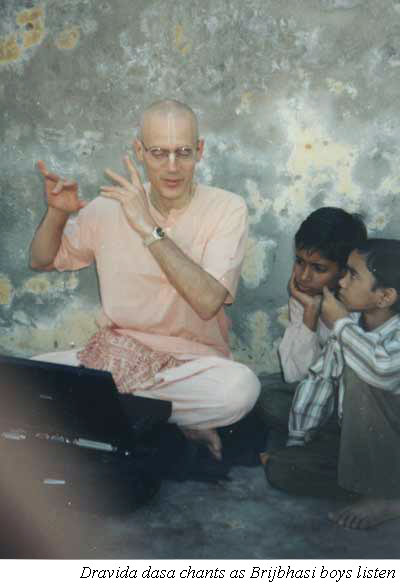 *
*
*
Dravida dasa is a Vaishnava monk, editor, musician, poet, and walking encyclopedia of devotional Sanskrit verse. He possesses a deep love for the Sanskrit language, and his mind and voice are always engaged in bhakti song and poetry. Here he immerses himself in the elaborate prosody of the Mukunda-mala-stotra of Kulasekhara Alvar. This podcast is forty-five minutes long with Sanskrit verses and English translation. I highly recommend setting some time aside, putting in the earphones and listening to the entire stotra with concentration for a very cathartic meditation. The translation is by Sriman Kushakrata dasa. Below, I’ve also included an excerpt from the introduction to the Bhaktivedanta Book Trust’s edition entitled Mukunda-mala-stotra, The prayers of King Kulasekhara. For more recordings from Dravida dasa click here.
Kaustubha das
Mukunda-mala-stotra
Right-click to Download as Podcast
[audio:https://bhakticollective.com/_multimedia/Mukunda-mala-stotra1.mp3]
Listen On This Site
Mukunda-mala-stotra
Introduction
Of the many hundreds of poetic Sanskrit stotras-songs of glorification offered to the Supreme Lord, His devotees, and the holy places of His pastimes-King Kulasekhara’s Mukunda-mala-stotra is one of the most perennially famous. Some say that its author conceived it as a garland (mala) of verses offered for Lord Krishna’s pleasure. It has long been dear to Vaishnavas of all schools, and our own spiritual master, Srila A. C. Bhaktivedanta Swami Prabhupada, frequently enjoyed citing certain favorite stanzas from it. King Kulasekhara was part of the Sri-sampradaya, the Vaishnava school founded by Lord Vishnu’s divine consort, Sri. This school’s most prominent representative, Ramanuja Acarya (eleventh century), built on the work of his predecessors Natha Muni and Yamuna Acarya and established the systematic philosophy of Sri Vaishnavism. But these acaryas came in an already old tradition, that of the ecstatic mystic poets called Alvars. The twelve Alvars appeared at various times in South India, in the area roughly corresponding to present-day Tamil Nadu. According to the tradition of the Sri Vaishnavas, the earliest Alvars lived more than five thousand years ago, at the start of the present age, Kali-yuga, while the most recent lived in the first millennium A.D. The Alvars’ Tamil poetry was collected in the Tiruvaymoli, revered by Sri Vaishnavas as their own vernacular Veda. On the strength of the Tiruvaymoli’s devotional authority, the Sri Vaishnavas claim to follow Ubhaya-vedanta, the dual Vedanta philosophy founded on both Sanskrit and Tamil scripture. Some Alvars were atypical renunciants: the third, Andal, was a woman, and three were involved in governing. Among these was the tenth Alvar, Kulasekhara Perumal, who was a ruling king in the Cera dynasty of Malainadu, in what is now Kerala. Modern scholars say he may have lived during the ninth century A.D. A traditional history of King Kulasekhara states that once, as he slept in his palace quarters, he had a brilliant and distinct vision of Lord Krishna. Upon awaking he fell into a devotional trance and failed to notice dawn breaking. The royal musicians and ministers came as usual to his door to wake him, but after waiting some time without hearing him respond, they reluctantly took the liberty of entering his room. The king came out of his trance and described his vision to them, and from that day on he no longer took much interest in ruling. He delegated most of his responsibilities to his ministers and dedicated himself to rendering devotional service to the Lord. After some years he abdicated the throne and went to Sri Rangam, where he remained in the association of the Krishna Deity of Ranganatha and His many exalted devotees. At Sri Rangam Kulasekhara is said to have composed his two great works: the Mukunda-mala-stotra, in Sanskrit; and 105 Tamil hymns, which were later incorporated into the Tiruvaymoli under the title Perumal-tirumoli. As the other Alvars do in their mystic expressions, in his Perumal-tirumoli King Kulasekhara emulates the roles of some of Lord Ramacandra’s and Lord Krishna’s intimate devotees: King Dasaratha; two of the Lord’s mothers, Kausalya and Devaki; and some of the young cowherd women of Vrindavana. But Maharaja Kulasekhara expresses no pride in realizing such confidential devotional moods. On the contrary, with deep humility he repeatedly begs simply to be allowed to take his next births as a bird, fish, or flower in the place where Lord Krishna enacts His pastimes, and in this way to enjoy the association of His devotees. The Mukunda-mala-stotra, although composed in elegant Sanskrit, is a simple expression of King Kulasekhara’s devotion to Krishna and his eagerness to share his good fortune with everyone else. Being thus a very public work, it does not delve into intimate personal revelations or abstruse philosophical conundrums. Like most other works of the stotra genre, it aims less at presenting a plot than at vividly and honestly expressing the true feelings of a lover of God. With this much we the readers should be completely satisfied, because it is a rare opportunity for us when a devotee of King Kulasekhara’s stature opens his heart so freely-and in a way just appropriate for us, with all our imperfections, to appreciate.
Text from Mukunda-mala-stotra, The prayers of King Kulasekhara, courtesy of The Bhaktivedanta Book Trust International, Inc. Used with permission.
Comments
One response to “Mukunda-Mala-Stotra”
Thank you for this. It seem lovely.